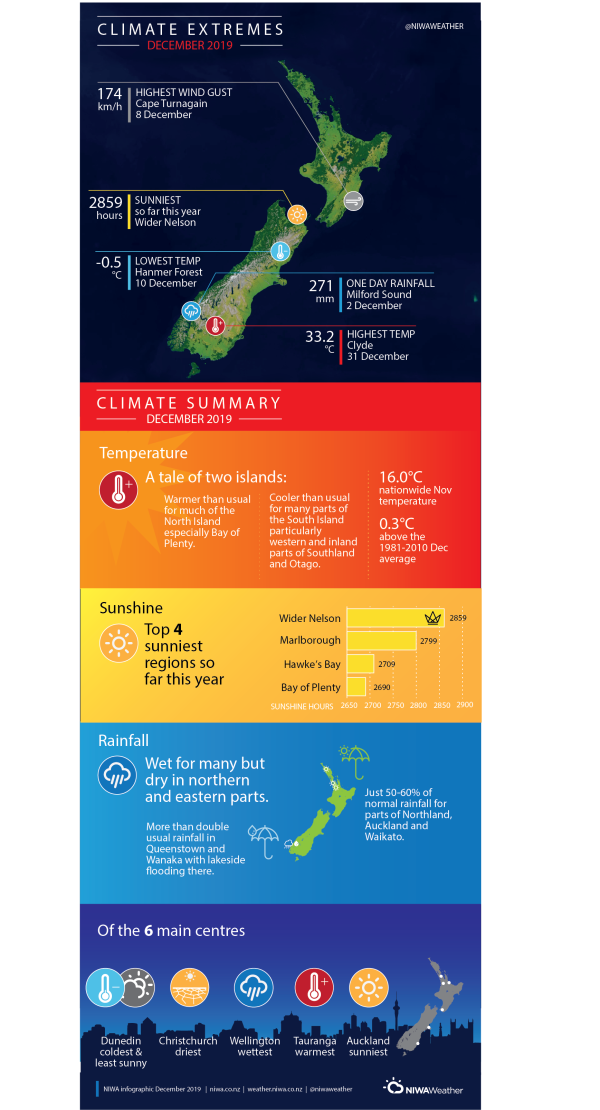Wet end to the year for much of New Zealand
|
Rainfall |
It was a wet December for much of the South Island, with well above normal rainfall (>149% of normal) in parts of every region. Rainfall was also well above normal in Wellington, Kapiti Coast, northern Hawke’s Bay and Gisborne. Above normal rainfall (120-149% of normal) was observed in parts of Taranaki, Manawatu and south-eastern Waikato. Rainfall was below normal (50-79% of normal) in Northland, Auckland, northern Waikato and Bay of Plenty, Coromandel, Wairarapa, eastern parts of Central Otago, and coastal Canterbury north of Ashburton. |
|
Temperature |
Temperatures were well above average (> 1.20°C above average) for Bay of Plenty, and parts of Waikato and Hawke’s Bay. Temperatures were mostly above average (0.51-1.20°C above average) for remaining parts of the North Island. Below average (0.51-1.20°C below average) or well below average (> 1.20°C below average) temperatures were experienced in western and inland parts of Southland, Otago, and along many additional areas about the Southern Alps. |
|
Soil Moisture |
As of 1 January 2020, soils were wetter than normal for the time of year across parts of Southland, Otago, Nelson, Marlborough Sounds and Wellington. Soil moisture levels were much lower than normal for the time of year in Northland, Auckland, northern Waikato and eastern parts of Wairarapa. |
Overview
December 2019 was characterised by lower than normal pressure over the country, and much lower than normal pressure to the southwest of the South Island. This pressure set up was associated with more westerly and south-westerly winds than normal. The prevalence of these winds (and the associated orographic effect) contributed to considerable rainfalls in the headwaters of the South Island lakes and rivers, with several notable flooding events (see Highlights and extreme events for further details). Conversely, parts of Northland, Auckland, Waikato and Bay of Plenty experienced many dry and sunny days throughout the month resulting in below normal rainfall totals, and soils becoming much drier than normal for the time of year. Overall, the nationwide average temperature in December 2019 was 16.0°C. This was 0.3°C above the 1981-2010 December average from NIWA’s seven station temperature series which begins in 1909.
Further highlights
- The highest temperature was 33.2°C, observed at Clyde on 31 December.
- The lowest temperature was -0.5°C, observed at Hanmer Forest on 10 December.
- The highest 1-day rainfall was 271 mm, recorded at Milford Sound on 2 December.
- The highest wind gust was 174 km/h, observed at Cape Turnagain on 8 December.
- Of the six main centres in December 2019, Tauranga was the warmest, Auckland was the sunniest, Christchurch was the driest, Dunedin was the coldest and least sunny, and Wellington was the wettest.
- Of the available, regularly reporting sunshine observation sites, the sunniest four locations in 2019 are Wider Nelson (2859 hours), Marlborough (2799 hours), Hawke’s Bay (2709 hours) and Bay of Plenty (2690 hours).
- Of the available, regularly reporting low elevation rainfall sites, the two wettest locations in 2019 are Milford Sound (8,417 mm) and Mount Cook Village (5,446 mm). The two driest locations in 2019 are Clyde and Cromwell (417 mm).


